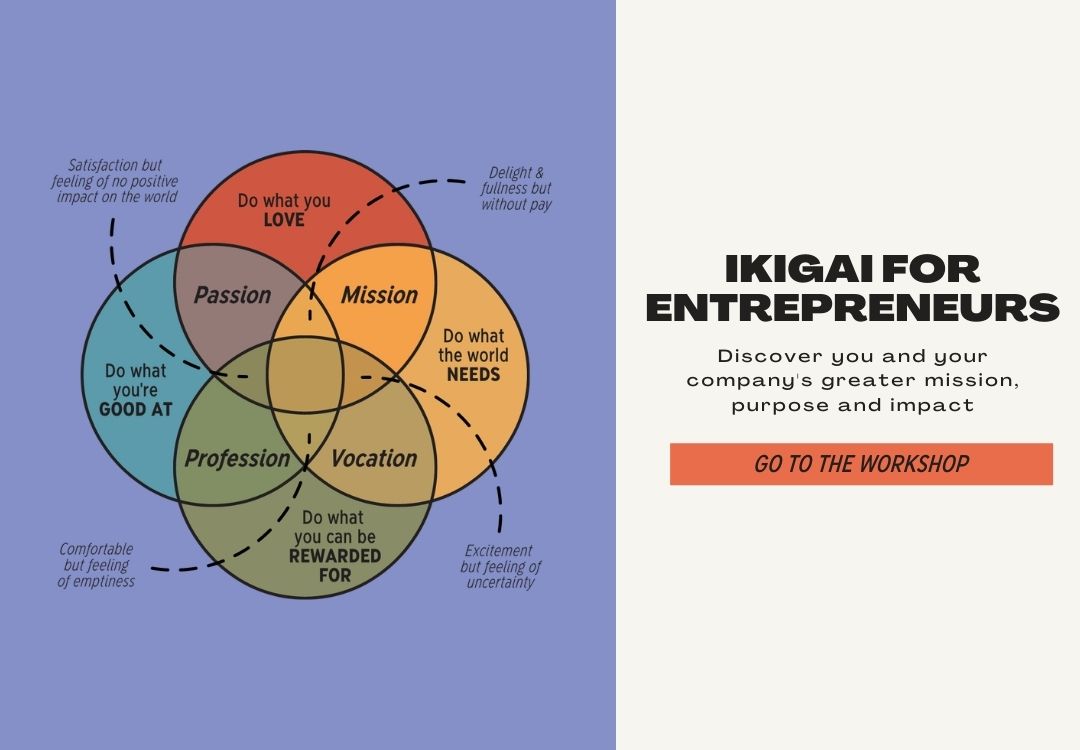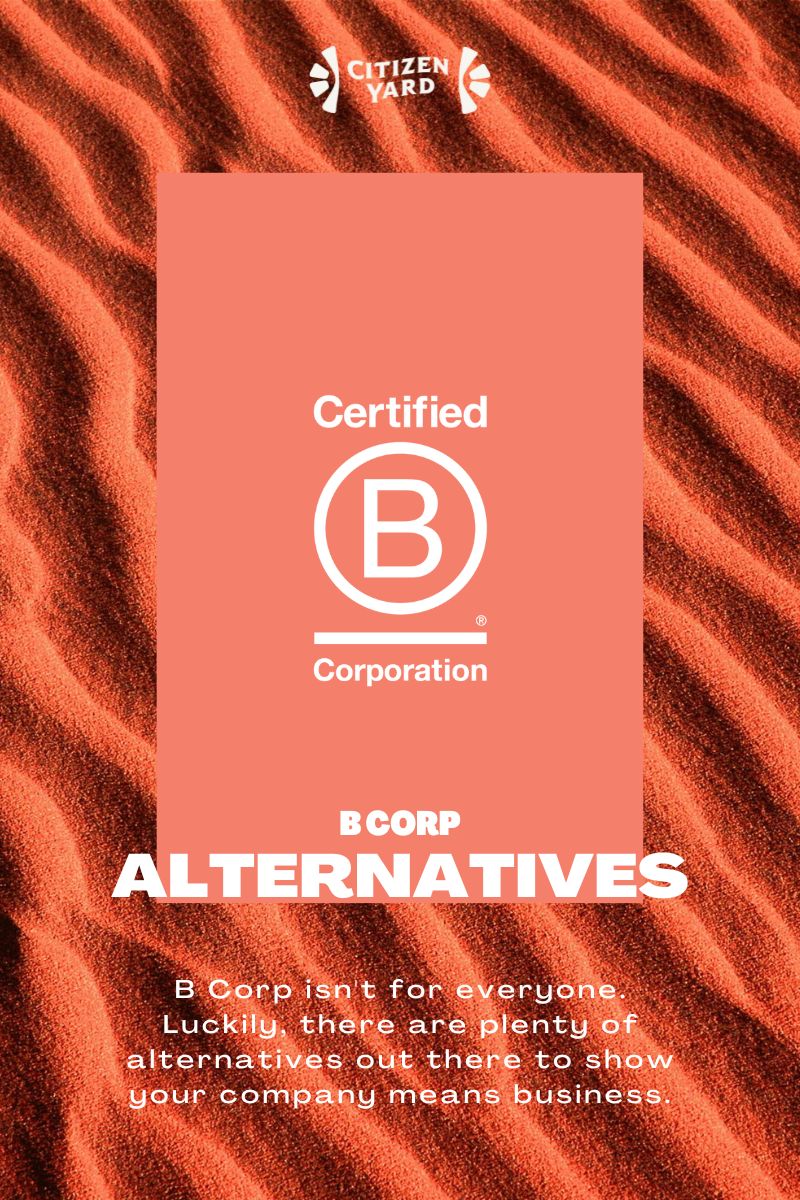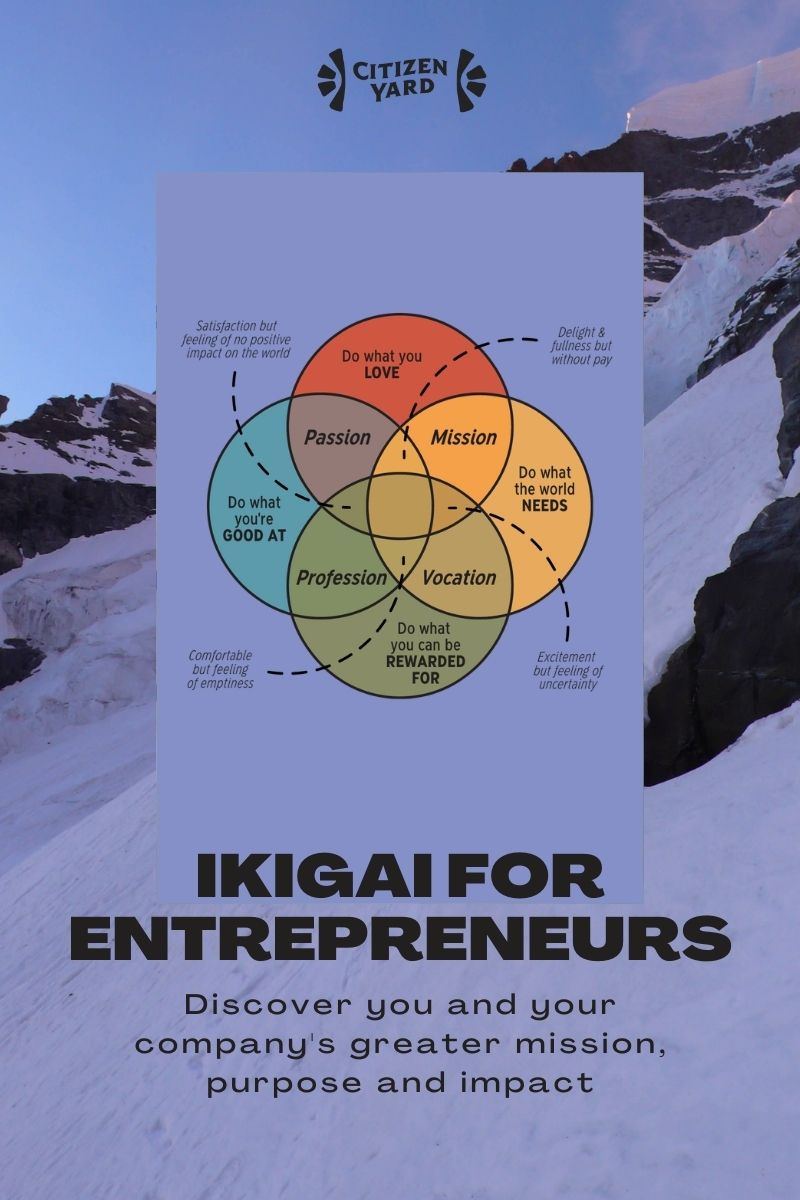
Write Your Company’s Mission, Vision & Values
Table of Contents
Do you feel like you’re floundering in your business decisions?
When it comes time to make a choice you feel stuck or overwhelmed. You struggle with knowing whether or not a decision aligns with your brand and what your company stands for.
Ultimately you put the decision off for another day and in the end, no decision is made. The result? You’re left plateaued, stagnant as a result of indecision.
You, my friend, are stuck in mission statement purgatory.
Stagnation and indecision often stem from a lack of knowing the bigger vision guiding your company. And when there’s no vision, there’s no guiding mission or values to back it up.
Let’s change that.
Developing a strong mission, vision, and values statement puts bowling bumpers on the alley lane of your company. Bumpers that will keep you from landing in the gutter and push you toward a perfect strike every time.
A company left without parameters is vulnerable to a toxic freedom to pursue anything. Great for exploration, not so much when you’re aiming to move in a singular direction. In your case, moving forward toward running a prosperous business.
In this article we’re going to get crystal clear on the mission leading your company, the values governing it, and the vision guiding it.
We’ll go beyond your average CSR checklist to put something in place that will bring life, authenticity, direction, and purpose to your company’s function.
***
The Mission Behind Mission
Why does a mission, vision and values statement matter?
Let me draw it out for you.
This is your brain without a mission, vision, values statement. Without a bigger vision. Without values to govern you.

This is your brain with a mission, vision, values statement.

Mission, vision, and values will give you clarity. I’m talking so much clarity you won’t know what to do with all that freed-up brainpower. Except you will know what to do, because clarity.
To begin wrapping our heads around the process, let’s look at how mission, vision, and values affect each other.

The mission statement proclaims why your company exists and how you achieve your vision. The vision declares what your company wants to become and achieve. The vision statement guides the strategy on how you will achieve the vision. Which affects the values by which you will conduct business. Which all leads to goals and objectives by which you define success.
In essence, the mission brings the vision to life. The vision is what you hope to bring to the world. And the values govern how you act on it all.
***
Create Your Company Mission, Vision & Values
Getting your mission, vision, and values down starts with referencing your company’s higher purpose.
For that, we look to the Entrepreneur’s Ikigai.
If you have no idea what we’re talking about, then we recommend working through the Ikigai journey to finding purpose before tackling you mission, vision, and values.
In the Ikigai workshop, you’ll get clear on what both you and your company are good at, what you love doing, what you can be rewarded for and what the world needs. All of which come together to articulate your company’s higher purpose.
Once you’ve gone through the purpose-finding process and know what you want your company to do to change the world — even if it’s vague, fuzzy or you’re not clear on the how just yet — then it’s time to move on to the mission, vision, values.
BEFORE WE BEGIN:
Your mission, vision, and values WILL mature as your company does.
What you create now will not be your mission, vision, and values forever. This is just the start. You put this in place now to guide you to a point in the future. Once achieved, you’ll re-evaluate to set revised goals for an even grander future.
Pull out the filled-in Ikigai you created for your company.
Are there any knee-jerk keywords, terms, ideas, or intuitions that stand out and make you want to explore further? Highlight them.
Do you see any patterns or overlapping ideas emerging from the data? Expand upon them.
The point of the Ikigai is to organize the chaos in your head. We’re looking for opportunity and those “ah-ha!” moments. Ikigai is here to sprout ideas, not be the end-all-be-all.
Is it mission then vision then values? Or vision then mission? Or values? Where do you begin?
What do you start with? Is it mission first, vision second and values third? Or do you get values down then vision and finally mission?
The truth is, there is no hard or fast rule. Companies have begun every which way.
We recommend starting with the obvious.
If you already have your product down and it fulfills a particular vision of how you want to see the world (ie. a company creating safe spaces for indigenous) then achieving that vision is where you’ll start. Other companies might find themselves governed by a particular value. Such as a hedge fund dedicated to complete transparency. In which case, values around transparency and anti- Wolf of Wall Street ethics reign supreme. So they would start there.
For this exercise, we’re sticking to the most-used trend of reference which is mission, vision, values.
***
Form Your Company Mission Statement
Your company’s mission statement must answer one simple question: why do you exist?
Concerning vision and values, the mission is governed by your company values and explains how it will execute your vision for the world.
Let’s look at the core components behind a good mission statement:
- State the what: the mission statement should declare what it is your company does
- State the who: who your company serves
- Free of fluff: mission statements should be clear and concise. Keep it to one or two sentences. Don’t use two words when one will do
- Authentic: a mission statement is realistic and free from hyperbole
- Compelling: mission statements are inspirational and memorable
- Relatable: your customer needs to see themself in the mission statement
- Defined: don’t be vague
Here’s what it looks like to put these components in action.
We’re going to use Envato, a Certified B Corp, as an example.
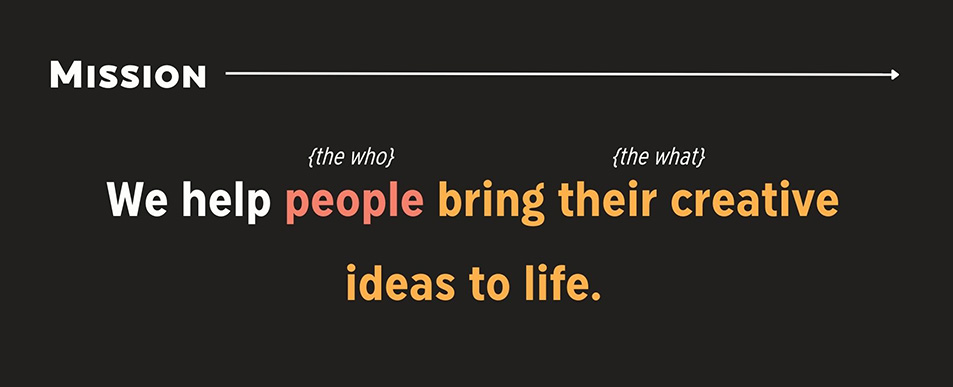
Envato is a world-leading community for digital designers of all kinds to discover assets, tools, and talent to bring their ideas to life. Their mission statement is spot on. It acknowledges who they serve and what they do in a single, actionable sentence.
The Mission Statement Framework
Working from Envato’s example, it’s time for you to put it into practice and develop your own mission statement framework. Remember playing mad libs as a child? We’re about to throw it back.
You’ll start out by filling in the following blanks:
- Your target market/ideal client: _________
- The problem or goal you company is trying to solve: _________
- Your company’s solution to the above problem or goal: _________
- The desired outcome for your target market/ideal client: _________
Got your blanks filled in? Good. Now we’re going to drop the answers into the mission statement framework.
We help {target market} with {problem/goal} , by {solution} so that they can {desired outcome} .
Feel free to add more eloquence or personality if you wish but this is a more than good starting point for developing a mission statement. After you’ve lived in your mission statement for a bit you will find the exact words to further enhance it.
***
Form Your Company's Vision
Vision is your company’s big picture. It’s how you will impact your community, industry, and the world at large.
The company vision needs to answer, “What will we become?” or “what do we hope to achieve?”
So let’s talk about what makes a company’s vision statement so special.
- Keep it centered in reality: it’s easy for a company's vision to span the horizons. But for actionality, you’ll want to keep things more grounded
- Alignment: keep the vision aligned with your company mission and core values
- Avoid metrics: this isn’t the time or place for numbers. While you don’t want to be vague, there’s no need to pull out the charts and graphs
- Ambition: the company vision needs to be a bit ambitious to move the needle forward
- Timebound: bookmark your vision within a 5-10 year timeframe
We’re going to look to Envato again and how they set their company vision.
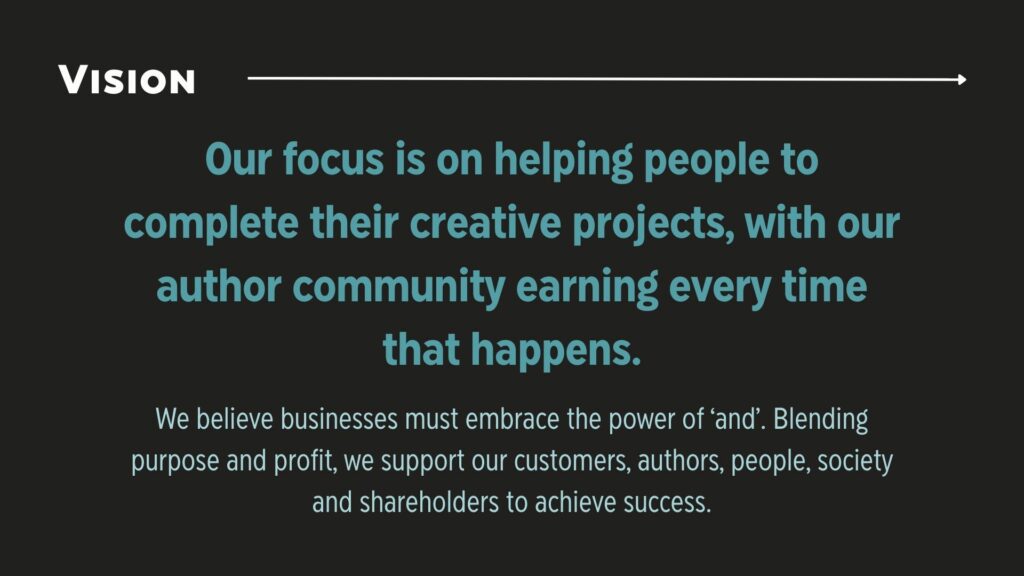
Note how the Envato’s vision paints a bigger picture for the mission statement and gives it a goal to strive for.
To start forming your own vision statement, pull out that ever helpful Ikigai. We’re going to make our way around the diagram paying attention to those keywords you highlighted earlier.
1. Declare The Outcome
In the mission statement, you declared why your company exists and what you do. Now you’ll take it a step further and declare the outcome of what you do.
The outcome of your company is the transformation your customer experiences as a result of your product or service.
For example, if you own a bike shop then selling bikes is what your company does. But the overall outcome is giving people the freedom to explore the outdoors.
For a healthy pet food company, you formulate and sell a more nutritious pet food. But the overall outcome is to feed people’s furry family members a nutritious diet that keeps them healthy and strong for years and years of happy memories.
When brainstorming your company’s outcome, pay attention to the profession and vocation sections of the Ikigai, especially if you’re not totally confident in your company’s higher mission statement just yet. Look at the words and phrases you’ve highlighted. What is the big benefit the client or customer will experience from working with or buying from your company?
A strong outcome alone won’t be enough for a proper vision statement but it’s the start.
2. What Makes You Different
Next, think about what makes your company different.
For this, consult the Zeal and Skill side of the Ikigai diagram. We want to find that extra oomph created by your company.
For some companies, that particular little je ne sais quoi is found within the product itself. Like the advent of nut milks or biodegradable paper and sugarcane straws. Another example is companies like DuckDuckGo and fellow B Corp, Ecosia. These smaller search engine companies dared to take on the goliath Google by bringing their own unique twist to search engines. For DuckDuckGo it’s their dedication to privacy. For Ecosia, its planting a tree for each search performed.
Other companies find their special something in the way they conduct business or through a stellar customer service experience.
That special thing that makes your company stand out is its Unique Selling Point (USP) which will be the crown jewel in rounding out the company’s vision.
But don’t get comfy yet. There are two more steps to complete the company vision.
3. Keep It Grounded
At this point, the company’s vision may be getting a little pie in the sky.
It’s great to have a company vision that shoots for the moon. That’s how we were able to put a man on the moon in the first place. But without grounding the vision in reality, your mission, vision, and values will be met with skepticism, cynicism, or plain old frustration when the vision is never achieved.
Let’s say you own a dog rescue. It’s great to want to save every dog in the world. I mean, don’t we all — if only it were so simple.
There are a few ways to ground this vision statement to make it more attainable.
- Specify the customer (Our vision is to find a home for retired and ex-race dogs)
- Give it a measurement (Our vision is to find homes for 2,000 dogs within the next five years)
- Specify a region (Our vision is to find a home for every dog in Kansas City)
No need to get too specific or caught in the numbers, our goal here is to just reel it in.
BONUS STEP: Add A Dose Of Humanity
Steps 1, 2 & 3 built the base of your vision. If you really want to nail it, add a dose of humanity.
Adding an emotional or sensory aspect to your vision is what’s going to draw people into a deeper sense of connection with your vision. When people resonate with a vision, they internalize it to help you act on it.
This step is a bonus step and may not be apparent from the start. Sometimes you have to dry on your vision like a new coat and live in it for a little before you find the right delivery of words to connect with customers on that deep, organic level.
***
Form Your Company's Values
Values are the core beliefs held by your company.
Values are your code of conduct. They are a filter when deciding what projects to pursue and what to pass on. Or when deciding what customers, suppliers, and partners to work with. Or when dictating what behavior is and isn’t acceptable from workers. They make up your company culture.
Values are what you convey to the public eye. They’re what you want people to think, feel and want when they hear your brand name.
Values are the heart of your company. Anyone who is part of your company or conducting business in your company’s name should embody and believe in your company values. I don’t think I go too far when I say it’s okay to not hire someone if they don’t at least believe in your values and agree to abide by them.
Let’s look again to Envato to see their approach to values.
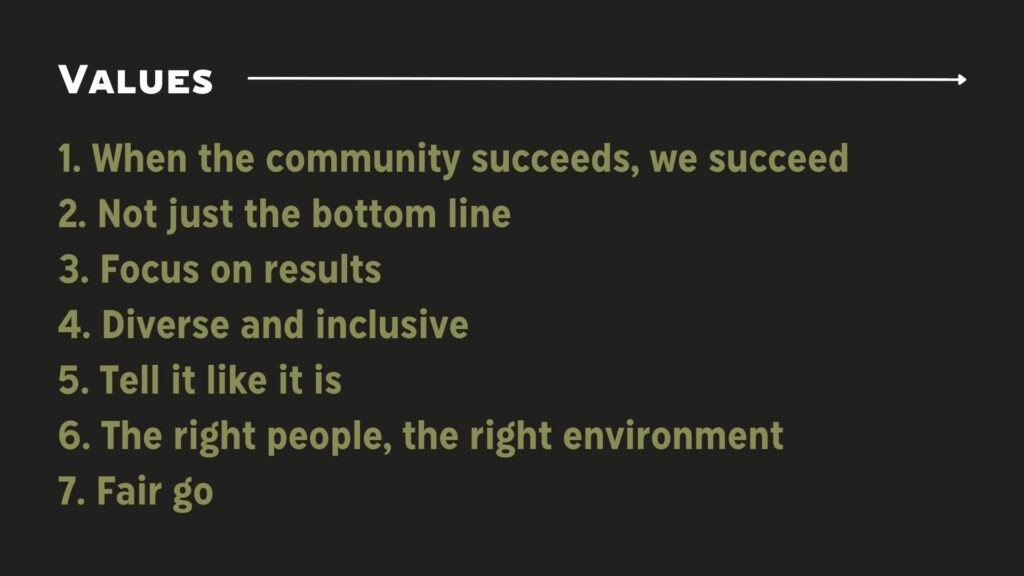
See how Envato’s values bolster its mission and vision? Their mission, vision, and values each expand upon the other. And when you look at it all together you can clearly see the thought process behind their company culture and bigger business strategy.
Time to choose your own company values.
When choosing your company values, don’t just put a bunch of vague, action-oriented-sounding words in a hat and select at random.

For this exercise, we highly recommend getting outside input. Work with a partner, colleague, or workers. If you’re a solo show, consult with a mentor or even customers. You don’t want to accidentally confuse your personal values with the company’s values. While it’s fine for them to influence one another, company values are a separate entity.
So how do you find your company values?
Some might argue that your company values already exist, you just have to define them. It really only takes one question to get to your values. The question is this:
What matters more to you and your company than money? Why?
The answer to this question is your values.
Other actions to further comb out company values are:
- Ask what has defined the company so far? Is there something in the company’s story or background that has a deep impact on how you do business?
- Make a list of the things you would NEVER do
- Listen: Consider the side and input of others (partners, customers, workers, mentors, etc.)
Once you’ve selected your company values, protect them. Abandoning core brand values and principles — even once — will destroy their long-term value.
***
Live It — Put Mission, Vision & Values Into Action
Now that you have your mission, vision, and values down the last thing you want to do is slap them in an internal business pitch deck and forget they exist.
It’s time to live it.
1. Create A Spirited Company Culture
Make your company’s mission, vision, and values the cornerstone of your company culture. Talk about them in both internal company discussions as well as in external campaigns.
2. Get Workers Onboard
Workers arguably make up the bulk of company culture. When workers are united around common ideas productivity thrives. When they’re splintered, work fragments as well. Get them onboard.
3. Lead By Example
Company leadership and managers must exemplify company values. Workers look to leadership to lead by example and take a cue from their behavior. Furthermore, you shouldn’t be asking your team to embody anything you wouldn’t do yourself.
4. Build Values Into The Onboarding Process
Shower workers and clients into your company culture right from the start by adding mission, vision, and values into the onboarding process. Let them know exactly what they can expect from your company.
5. Build Values Into Workflows
There are ways to communicate mission, vision, and values that go beyond the verbal. You can reinforce culture by subtly building it into your workflows.
For example, if intently listening to customers is a value, you can create opportunities for clients to engage with your company throughout the customer journey. Add a help desk directly on the website. Include short customer feedback questionnaires after interactions. Host weekly Q&As or invite them to the table. All these actions say “we listen to our customers,” without ever having to say it.
These are just a few ideas to get started living your company culture. The important thing to remember is to simply live out your mission, vision & values in whatever way that looks like for your company.
***
Wrap Up
Don’t underestimate the importance of creating a clear mission, vision, and values for your company. They create your company culture and are the compass for making critical business decisions.
THE MISSION STATEMENT proclaims why your company exists and how you achieve your vision.
THE VISION is the big pictures. It declares what your company wants to become and achieve.
BIG DECISIONS & STRATEGY are formed based on the company vision and mission.
VALUES are your code of conduct and the backbone to company culture.
GOALS & OBJECTIVES are how your define success in both profitability and adherence to mission, vision, and values.
Once you have your mission, vision, and values down, LIVE THEM TO THE FULL!
Resources
Learn more about building and living your company’s mission, vision & values.
Hubspot | 27 Mission and Vision Statement Examples That Will Inspire Your Buyers
Share :
Key Takeaway
Don’t underestimate the importance of creating a clear mission, vision, and values for your company. They create your company culture and are the compass for making critical business decisions.
Next Up
Join our weekly Backyard Tailgate, a newsletter to help brands live out their mission & lead with purpose.
Each Tuesday we visit your inbox to share what we’ve learned on our own impact journey, resources, tips & tricks and introduce you to some of our world changing friends. We keep it real. We keep it honest. But most importantly, we keep it actionable.
